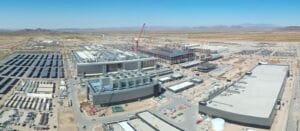Mixed Use Medical Buildings
Banner Health Systems’ 60-acre Gateway campus in Gilbert is buzzing with activity. The 120,000 SF MD Anderson Cancer Center is rising from the construction dust, a new mixed use medical office building was just completed, and an older office complex is being renovated and expanded.
The same healthcare giant just announced plans to build the Banner Health Center, housing doctors offices plus a variety of medical and lab services, on 11 acres in the Wells Retail Center in Maricopa.
And in one of the most unusual mixed use medical pairings, Arizona’s most prolific retail developer, Westcor (owned by Macerich), is teaming up with venerable healthcare provider John C. Lincoln to plot out 84 acres in northwest Phoenix for a community hospital/medical office/retail center/auto mall.
Healthcare-anchored, mixed use developments seem to be the current real estate trend. There are dozens around the state. Some are hospital centered, and others, such as the proposed Maricopa project and the 50-acre Arizona Health & Technology Park in Mesa, are designed to combine medically focused businesses and other community services.
The Mesa project’s plans include space for a dental clinic to serve the nearby Arizona School of Dentistry, other specialty outpatient service facilities, offices, and biotech research and development facilities.
Hamilton Espinosa, national healthcare specialist for DPR Construction, says clustering a variety of medical uses and complementary services is a national trend, not just a local one.
New hospitals are seldom designed as stand-alones. Campuses are master planned to grow as the surrounding community does, with room for expansion of inpatient beds, outpatient services and other ancillary services from specialized clinics to doctors’ offices to pharmacies and even restaurants and hotels.
It’s a natural progression, Espinosa says. Evolving medical technology has transformed many treatments that previously required a hospital stay into outpatient procedures. Add to the mix the need to rein in healthcare costs and — in Arizona, at least — a bounty of land.
Purchasing and master planning a big chunk of property, but building components as population and changing medical needs progress, makes sense in a cost-conscious and rapidly changing environment, Espinosa says.
He compares the mega-campus evolution to Arizona Department of Transportation (ADOT) planning of the state’s freeway needs.
“Healthcare providers have to be much more judicious in capital spending. There is more apprehension,” Espinosa says. “Like ADOT, they build what they can afford now and add later when they can afford it and as the census dictates (demand).”

But far from being something new, master planning a campus that blends medical and other business services is old hat to Plaza Companies, says Sharon Harper, president of the Arizona-based real estate company.
Plaza pioneered the first mixed use, medically-anchored community in Peoria in 1982, Harper says. Plaza del Rio’s 185-acre campus was originally designed to meet all the needs of an active senior living complex and grew over time to also meet the needs of the thousands of employees who work in the ever-expanding community, Harper says.
It includes senior residences, skilled nursing facilities, dozens of doctors and dentists offices, several specialty hospitals, clinics and other outpatient medical centers, condos, apartments, shops, restaurants, schools, offices, science and research facilities. But there’s not a traditional inpatient hospital in the mix.
Next on the drawing board, according to Harper, are single-family homes.
Plaza del Rio is a hugely successful one-of-a-kind model of a medically-anchored, mixed use development, but Harper says big hospital-anchored campuses and small neighborhood-focused complexes are essential to the future of healthcare delivery.
Jason Meszaros, vice president for Irgens Healthcare Development Partners, which just completed Mercy Medical Commons, a medical office project adjacent to the Mercy Gilbert Medical Center campus, agrees that there is no one-size-fits-all solution. Arizona is relatively saturated with hospital beds, Meszaros says.
“The trend is we are done building hospitals for a while,” he adds.
The Desire For Mixed Use Medical Buildings
The focus for the foreseeable future will be filling out space on existing campuses with other services that make a hospital more competitive as a destination for patients, as well as for doctors and surgeons who want on-campus offices to cut daily commute times from inpatient to outpatient visits, he says.
“A hospital becomes an anchor for all types of real estate needs,” Meszaros says. “You most likely have hospitality needs, places for a family to stay. And you have lots of people who work there and in offices, and that drives retail. You need some place to eat lunch.”
But a bounty of available land on hospital campuses is only one motivation for mixing up healthcare real estate and other uses.
The changing needs and desires of aging baby boomers and new healthcare reform measures are also factors driving how and where medical services are provided now and into the future, says John Driscoll, president of Alter+Care, the healthcare division of the Alter Group. The company is developing the Arizona Health & Technology Park in Mesa.
“Boomers have been market changers over the years,” Driscoll says. “And the first boomers will be retiring this year.”
Lifestyle demands and the bubble of people moving to Medicare during the next two

decades will require medical services that are more “competitive, attractive and affordable,” he says. And another 30 million insured people, many on Medicaid-like systems, means cost-effective real estate solutions will be key.
“There is no question in the future that healthcare providers will have to be more efficient,” Driscoll says.
Rather than a single model for healthcare real estate in the foreseeable future, there are several scenarios likely to emerge simultaneously based on a community’s needs and assets, he continues.
The giant, hospital-anchored campuses make sense for regional medical services, but the future focus will emphasize bringing healthcare closer and making it more convenient to those who use it on a regular basis.
Driscoll envisions smaller neighborhood-based destinations with a range of services such as medically-based fitness centers, post-surgery rehabilitation facilities, sports performance centers — “health villages with different kinds of services for people who are sick and to keep people well.”
“We’re seeing more co-mingling of medical and wellness services,” he says.
Future development also will be real estate-driven and may include adapting empty big boxes retailers to house medical services, he adds. Picture the shell of a former Borders Books or Ultimate Electronics housing a host of medical providers, such as acute care clinics, labs and medical imaging services.
Randy McGrane, managing director for Ensemble Real Estate, has already imagined that as the future of outpatient healthcare delivery. He adds that off-campus medical services are a bigger trend than the expansive hospital-centered developments.
The ratio of inpatient to outpatient medical services is about 60/40 now, McGrane says, but he predicts the numbers will reverse within 10 years.
Communities want medical services in their own neighborhoods, and retail centers are suffering from curtailed discretionary spending during the recession, he says. So, the empty retail anchor spaces are obvious and cost-effective solutions for both real estate segments.
In smaller neighborhood strip centers abandoned by a supermarket anchor, adding a clinic or urgent care facility could change the whole dynamic of the center. It could spawn new medical and/or retail services such as pharmacies or health-food shops, and the same type of services — dry cleaners, casual eateries and coffee shops, for example — that cluster around a supermarket to make a neighborhood commercial center a one-stop convenience for employees and customers, McGrane says.
And adding medical outpatient facilities to a big box-laden power center can re-energize flagging retail, bringing in new foot traffic and boosting business for all tenants, he says.
So who are the visionaries on top of the trends in changing healthcare delivery systems? Savvy industry giants already are planning multi-faceted networks that add satellite services in diverse locations, as well as boosting hospital campuses with a variety of services to remain competitive, according to the local industry experts.
The major players plotting out Arizona’s healthcare delivery systems of the future are the top hospital names, such as Scottsdale Healthcare, Banner Health, Catholic Healthcare West, John C. Lincoln and Abrazo Health Care, according to industry experts.
And the on-the-ball real estate developers, designers and construction companies have healthcare divisions in place ready to make it happen.
“There is growth in healthcare and in more sophisticated delivery of healthcare services,” Harper of Plaza Companies says. “It’s an exciting industry.
[stextbox id=”info”]
www.altergroup.com
www.dpr.com
www.ensemble-llc.com
www.irgensllc.com
www.theplazaco.com
[/stextbox]



